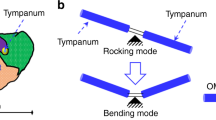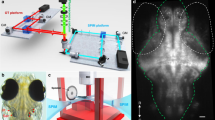Abstract
The physics of sound propagation imposes fundamental constraints on sound localization: for a given frequency, the smaller the receiver, the smaller the available cues1. Thus, the creation of nanoscale acoustic microphones with directional sensitivity is very difficult. The fly Ormia ochracea possesses an unusual ‘ear’ that largely overcomes these physical constraints2,3,4,5; attempts to exploit principles derived from O. ochracea for improved hearing aids are now in progress6. Here we report that O. ochracea can behaviourally localize a salient sound source with a precision equal to that of humans7. Despite its small size and minuscule interaural cues, the fly localizes sound sources to within 2° azimuth. As the fly's eardrums are less than 0.5 mm apart, localization cues are around 50 ns. Directional information is represented in the auditory system by the relative timing of receptor responses in the two ears. Low-jitter, phasic receptor responses are pooled to achieve hyperacute timecoding8,9. These results demonstrate that nanoscale/microscale directional microphones patterned after O. ochracea have the potential for highly accurate directional sensitivity, independent of their size. Notably, in the fly itself this performance is dependent on a newly discovered set of specific coding strategies employed by the nervous system.
This is a preview of subscription content, access via your institution
Access options
Subscribe to this journal
Receive 51 print issues and online access
$199.00 per year
only $3.90 per issue
Buy this article
- Purchase on Springer Link
- Instant access to full article PDF
Prices may be subject to local taxes which are calculated during checkout



Similar content being viewed by others
References
Michelsen, A. in The Evolutionary Biology of Hearing (eds Webster, D. B., Fay, R. R. & Popper, A. N.) 61–78 (Springer, New York, 1992).
Robert, D., Amoroso, J. & Hoy, R. R. The evolutionary convergence of hearing in a parasitoid fly and its cricket host. Science 258, 1135–1137 (1992).
Robert, D., Miles, R. N. & Hoy, R. R. Tympanal mechanics in the parasitoid fly Ormia ochracea: intertympanal coupling during mechanical vibration. J. Comp. Physiol. 183, 443–452 (1998).
Miles, R. N., Robert, D. & Hoy, R. R. Mechanically coupled ears for directional hearing in the parasitoid fly Ormia ochracea. J. Acoust. Soc. Am. 98, 3059–3070 (1995).
Robert, D., Read, M. P. & Hoy, R. R. Tympanal hearing in tachinid flies (Diptera, Tachinidae, Ormiini): The comparative morphology of an innovation. Cell Tissue Res. 284, 435–448 (1996).
Gibbons, C. & Miles, R. N. in Proceedings of the IMECE 5–20 (ASME, Orlando, Florida, 2000).
Fay, R. R. Hearing in Vertebrates: A Psychophysics Databook (Hill-Fay Associates, Winnetka, Illinois, 1988).
Rose, G. & Heiligenberg, W. Temporal hyperacuity in electric fish. Nature 318, 178–180 (1985).
Kawasaki, M., Rose, G. & Heiligenberg, W. Temporal hyperacuity in single neurons of electric fish. Nature 336, 173–176 (1988).
Walker, T. J. Phonotaxis in female Ormia ochracea (Diptera: Tachinidae), a parasitoid of field crickets. J. Insect Behav. 6, 389–410 (1993).
Cade, W. H., Ciceran, M. & Murray, A. M. Temporal patterns of parasitoid fly (Ormia ochracea) attraction to field cricket song (Gryllus integer). Can. J. Zool. 74, 393–395 (1996).
Ramsauer, N. Phonotactic Behavior of Ormia ochracea (Diptera: Tachinidae, Ormini) in Controlled Acoustic Conditions. Thesis, Univ. Zurich (1999).
Robert, D. & Willi, U. The histological architecture of the auditory organs in the parasitoid fly Ormia ochracea. Cell Tiss. Res. 301, 447–457 (2000).
Bair, W. & Koch, C. Temporal precision of spike trains in extrastriate cortex of the behaving macaque monkey. Neural Comput. 8, 1185–1202 (1996).
Carr, C. E., Heiligenberg, W. & Rose, G. J. A time-comparison circuit in the electric fish midbrain. I. Behavior and physiology. J. Neurosci. 6, 107–119 (1986).
Maršálek, P., Koch, C. & Maunsell, J. On the relationship between synaptic input and spike output jitter in individual neurons. Proc. Natl Acad. Sci. USA 94, 735–740 (1997).
Rieke, F., Warland, D., de Ruyter van Steveninck, R. R. & Bialek, W. Spikes (MIT, Cambridge, Massachusetts, 1997).
Batschelet, E. Circular Statistics in Biology (Academic, New York, 1981).
Acknowledgements
We thank T. Adelman, D. Bodnar, B. Land, R. Wyttenbach, M. Andrade and all participants of NEJC. This work was supported by an NIH grant to R.R.H.
Author information
Authors and Affiliations
Corresponding author
Rights and permissions
About this article
Cite this article
Mason, A., Oshinsky, M. & Hoy, R. Hyperacute directional hearing in a microscale auditory system. Nature 410, 686–690 (2001). https://doi.org/10.1038/35070564
Received:
Accepted:
Issue Date:
DOI: https://doi.org/10.1038/35070564
This article is cited by
-
Antlion larvae localize long distant preys by a mechanism based on time difference
Journal of Comparative Physiology A (2024)
-
An mm-sized biomimetic directional microphone array for sound source localization in three dimensions
Microsystems & Nanoengineering (2022)
-
Target-oriented Passive Localization Techniques Inspired by Terrestrial Arthropods: A Review
Journal of Bionic Engineering (2022)
-
Responses of intended and unintended receivers to a novel sexual signal suggest clandestine communication
Nature Communications (2021)
-
Visual motion integration of bidirectional transparent motion in mouse opto-locomotor reflexes
Scientific Reports (2021)
Comments
By submitting a comment you agree to abide by our Terms and Community Guidelines. If you find something abusive or that does not comply with our terms or guidelines please flag it as inappropriate.



